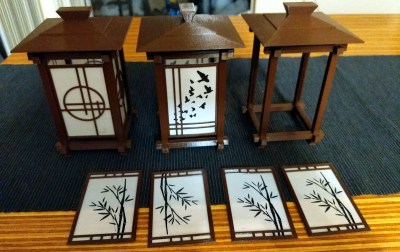The gorgeous Shoji-style lamps you’re seeing here aren’t made of wood or paper. Beyond the LEDs illuminating them from within, the lamps are completely 3D printed. There aren’t any fasteners or glue holding them together either, as creator [Dheera Venkatraman] used authentic Japanese wood joinery techniques to make their components fit together like a puzzle.
 While we’re usually more taken with the electronic components of the projects that get sent our way, we have to admit that in this case, the enclosure is really the star of the show. [Dheera] has included a versatile mounting point where you could put anything from a cheap LED candle to a few WS2812B modules, but otherwise leaves the integration of electronic components as an exercise for the reader.
While we’re usually more taken with the electronic components of the projects that get sent our way, we have to admit that in this case, the enclosure is really the star of the show. [Dheera] has included a versatile mounting point where you could put anything from a cheap LED candle to a few WS2812B modules, but otherwise leaves the integration of electronic components as an exercise for the reader.
All of the components were designed in OpenSCAD, which means it should be relatively easy to add your own designs to the list of included panel types. Despite the colorful details, you won’t need a multi-material printer to run them off either. Everything you see here was printed on a Prusa i3 MK3S in PETG. Filament swaps and careful design were used to achieve the multiple colors visible on some of the more intricate panels.
If the timeless style of these Japanese lanterns has caught your eye, you’ll love this beautiful sunrise clock we covered last year.















If I weren’t putting these outside I would definitely use wood PLA for the cases then give them a nice stain.
Awesome design and execution.
Any recommendations for good wood pla? I tried the mg chemicals wood pla because I found it locally and stain didn’t take well.
I’ve used the Hatchbox wood, sanded and stained (minwax walnut), and had great results.
I’ve been wondering if someone would ever make a wood PETG! Atomic Filament makes a gorgeous Marble PETG that looks like real stone but I’ve been wanting wood-looking PETG. PLA just doesn’t work for outdoors :-/
Why not swap the glass with an e-ink display?
Feel free
Seems like it’d work. If you want to maintain the interior lighting that looked like it came from a single point source then you’d need one that was translucent and I’m failing to find such a thing (might exist, I only looked for like a minute or two). Of course if you don’t care about interior lighting or can find a module that does even lighting across the whole thing and are ok with it then I can’t imagine any immediate problems with it. It’s a bit of a rube goldberg approach to the original design, but hey it’s hack-a-day, complicated elegance is 100% allowed :D
I wonder if rice paper (or other paper) could be substituted for the first layer.
Great idea, but there might be a problem with the filament sticking to it. If you give it a try, report back.
Thanks for explaining the multicolor technique, I didn’t know this was possible and it’s a really nice new option for designs. Love the lamps, too :-)
I printed them and they’re really good looking lamps. They are a little hard to put together, and I broke off the ends a couple of times. They were easy to superglue back though. The biggest issue I had was since the white part of the inserts are only one layer thick, they look like lines (and some come apart) and don’t fill out like the ones in the pictures. I did use PLA, so maybe that’s the issue. I’m going to try PETG next time. I like the rice paper idea above if you can get the filament to stick to it. Amazing project though and well worth the time!
I can definitely see that happening with PLA — they are pretty tight tolerances and PLA snaps pretty easily — should be less of an issue with PETG. Regarding the lines coming apart though that sounds like a first layer calibration issue — your first layer Z may be slightly high — the filament should get a slight “squeeze” onto the build plate to make the first layer one clean sheet.